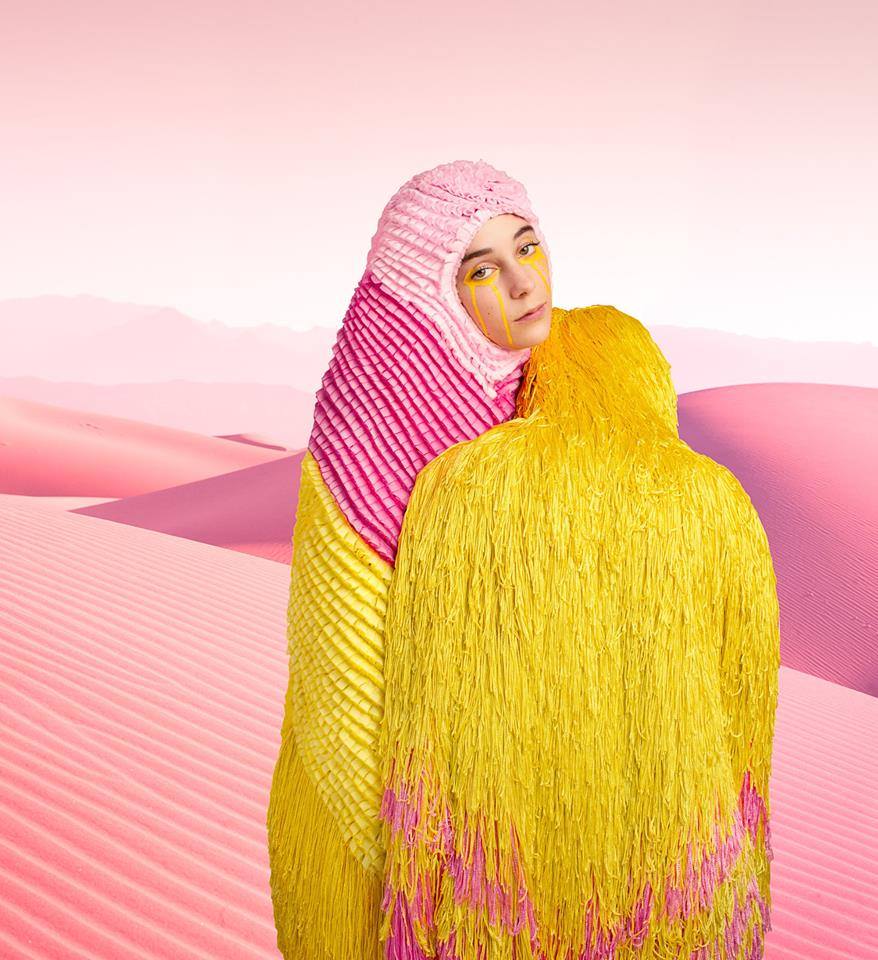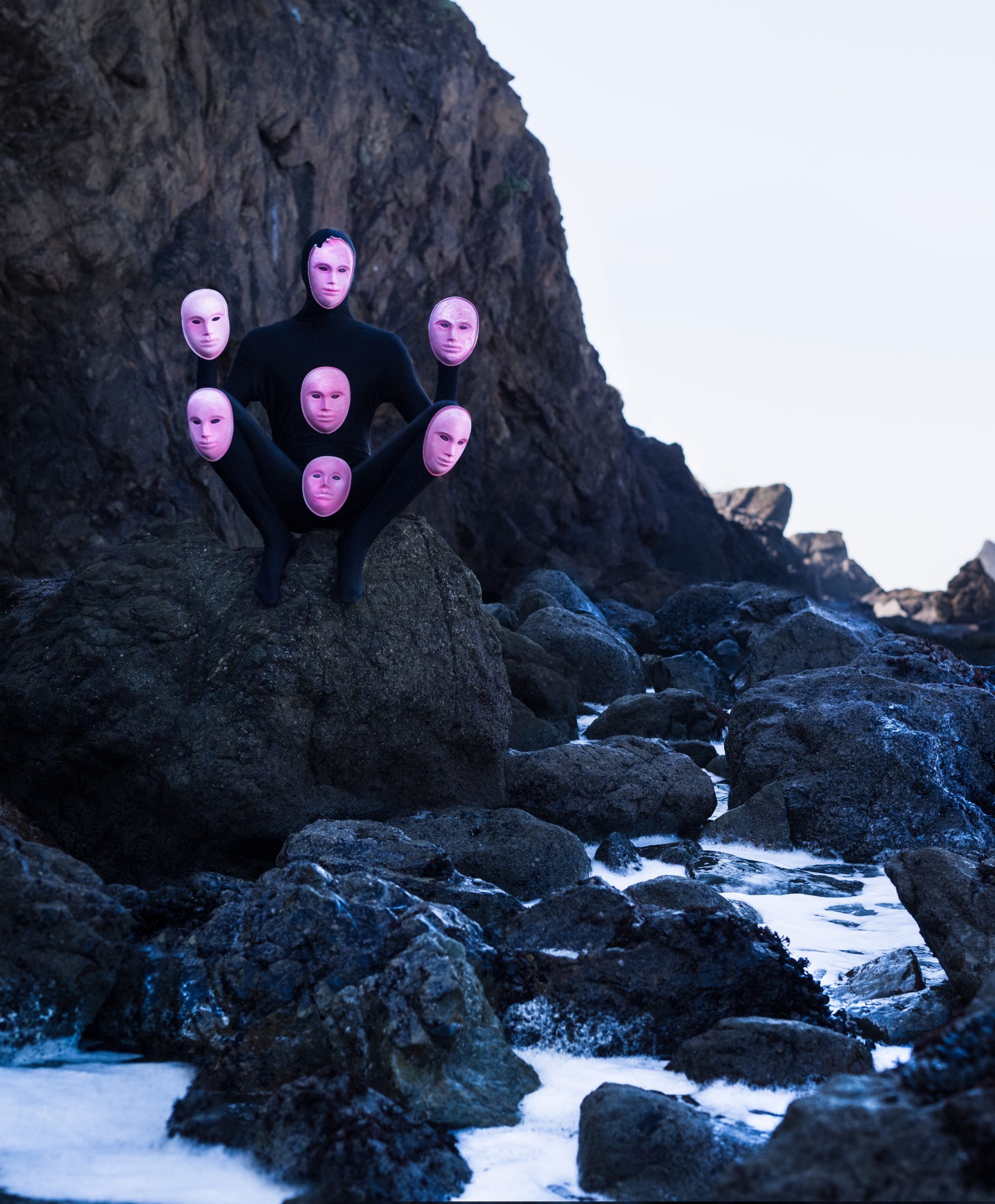We talked with the artist, theater and fashion designer, who makes those three disciplines one.
Puedes leer esta entrevista en español aquí.

I found work of Masha Kechaeva, costume and theatre designer, reviewing among Russian artists who combines art with philosophy and design. Masha fits perfectly between this transdisciplinarity, in fact she uses it to express through multiple elements, thoughts and questions in her own language.
In theatre she creates scenography and costume design; she works with photography, writes, directing music videos, creates installations and objects. “I’m not limited to techniques and I’m interested in exploring new things, the tool depends on the subject,” she explains.
Theatre attracts her by the synergy of the arts. This is what she says: “In a play there is an equal importance among the actors, the light, the sound, the set, the video, the script and the costumes … This is an alchemy of art, and I take this pattern from the theatre by not framing myself with specific responsibilities in my own projects. ”
Masha works with what is invisible at the first sight. She finds inspiration in archives, excavations in a metaphorical way, in something what is hidden, as she did in her project Radiolarian choir, where she turned drawings of microorganisms into human sized costumes. “Working with the shadow sheds light on the present… Buckminster Fuller said that the purpose of our life is to walk towards the rainbow, which means that there is no goal and the only thing that remains is to be in the moment and perceive what surround you, work with what you observe / feel, with what touches you”.
Her work is related to revolts, punk and feminism, which has led her to work with the choreographer of Pussy Riot team. She has unique and particular perspectives on fashion and the fashion system.

Masha establishes the importance of her life without separating it from the art. It is surrounded by art constantly, there are no borders between her daily life and the process of creation.
“What we call punk and riot in fact are critical assessment of reality and it is impossible for me as an artist to work without it”, Kechaeva tells me in a digital conversation.
Do you think fashion is revolutionary?
The revolution, if we look at the definition in the dictionary, is “a radical transformation in any area of human activity, a leap in the development of society (from the late revolution, a turn, revolution, transformation) associated with an open break with the previous one.”
So it’s not where we are now. The fashion world is on the stagnant level – we are witnessing an unhealthy mechanism of production clothes, hard working conditions for people in factories, overproduction of clothes by giant corporations, violations of human rights and environmental degradation.
The revolution begins in the consciousness of society. It is necessary to reconsider the attitude to fast fashion, owr view of nature only as a source of raw materials and to establish a relationship with the cultural heritage. Each of us is responsible for the reality that we observe, and we are all part of this mechanism – either owners / participants in sales or consumers.
And as long as we practice the unconscious consumption, we support the system and then changes are not gonna come.
How have you felt the development of fashion from social processes?
Fashion is a part of our modern history. Style does not know social/class boundaries. Fashion existed only for elites in the beginning, but only for those who could afford it, then, from with the beginning of the industrial era, the mass production of fashionable clothes has allowed to many people to use fashion as a tool to improve their appearance, as a mean of self-expression (in the same time this opportunity was based on a slave working conditions, who were predominantly female workers).
And also, it has co-opted many styles that belonged to the non-elites, which has its dark side, but makes fashion more accessible and diverse as a visual tool.
Fashion could’t and can’t develop without the influence of sport, music, cinema and television – they all has influenced the idea of how to dress. And journalism, advertising and photography has fixed these images in the mass consciousness.
It still works like an insertion of the consciousness, an implanted chip of illusion into human’s mind. The way people want to spend their free time, how they see themselves, how they see society and, of course, how they wanna look like. This is a fast and false way of expressing individuality (the mechanism of fashion-copying others overscores this individuality).
And then we are on this path surrounded by the fog of convincing and attractive resemblance of life. We were involved not in the direct process of imitation, but drawn into the process of identification and details of this process are seldom comprehended.

What is the relationship between the monstrous and style and fashion?
I think that they are united by irony and contradiction. The artist creates an image. Then media, magazines and television (and sometimes artist itself) bring it to the grotesque level. That’s how sometimes the real body is replaced with the abstract, ideal, impossible, rather an idea than an organism.
Then there is a strong desire to fit to this ideal with a help of all sorts of resources, sometimes even by the cost of losing one’s own personality and buying the ready one, prepared by fashion magazines, brands and advertising.
And if traditionally ‘monstrous’ (as definition) is an innate difference / ugliness from others, in our time it can become acquired as a result of the race for the elusive ideal of beauty, blinded by the idea of the body as something unchangeable and eternal, that can be infinitely adjusted and improved. And as a radical form of this improvement is the transformation of the body in the name of fashion (we all have seen pictures of victims of plastic surgery).
The fashion world protects us from the memory of disruption and replace it with a reliable and well-tried image, the boundaries of which do not spread out and clearly visible.
It’s harder with a feeling of a style that needs a dialogue with inner self, and in this contact psychological “I” often lost and blurred. But if the dialogue has been started it’s possible to find and develop your own style with a sense of experiment, but still based on your own internal preferences and feelings.
It is difficult to talk about any rules here – the fashion world defines normality, then this normality turns into the category of ugliness and after a dozen years it sung as an ideal of beauty again. I can not look at it without irony.

What is your design philosophy?
Every project/story/collaboration is an experience that I try to interpret as people interpret dreams – you never get involved in any work without a reason. This is a way out of the comfort zone. This is a meeting with unknown initiated by myself or someone else, this is something that irritates the sense of security. And this is a pure joy.
I do not like to make ready-made statements – in fact, I do not always know what sort of result to expect in the end and how it will transform. I do not want to limit myself with rigorous interpretations. This is not my task.Susan Sontag in her work “Against Interpretation” wrote the following: “Transparence is the highest, most liberating value in art-and in criticism today. Transparence means experiencing the luminousness of the thing in itself, of things being what they are.”
And I’m trying to experience this luminosity and then transmit it.I think what I do is not really mine, I do not possess it, I am only a conductor, and my task is to listen and then deliver.
The modern theater as well as the fashion theater grew out from the ancient religious mystical and magical past, from the ritual. And an important part of my artistic research, whether it’s working on a theatre play or my personal project is studying rituals, hidden meanings, symbols, unconscious memories and dreams. It is important for me to keep in touch with what shifts the point of perception and introduces into a state of dissociation and disorientation.

What is the future of fashion?
It would be good if we began to see the world as a whole, where problems are solved with the help of the intellect. Where the fashion revolution would go to the stage of evolution. And, as I already wrote above, the paradigm of fashion business would be revised. The future of fashion is where people, regardless of race, class, gender, age and abilities, are provided with equal opportunities and decent working conditions, observing safety techniques at each stage of production. All participants have a fair pay, without exploitation and discrimination.
The future is where people respect culture and heritage, where the figure of the artisan is valued. The future of fashion is where they take care of the environment and practice conscious consumption.
The world of fashion does not deplete the valuable resources of the planet, does not destroy the soil and does not pollute the air and water. The world of fashion is safe for human health. Fashion is on the side of all living beings and protects the diverse ecosystems of our planet. It sounds like the future. I want to believe that it is close.








